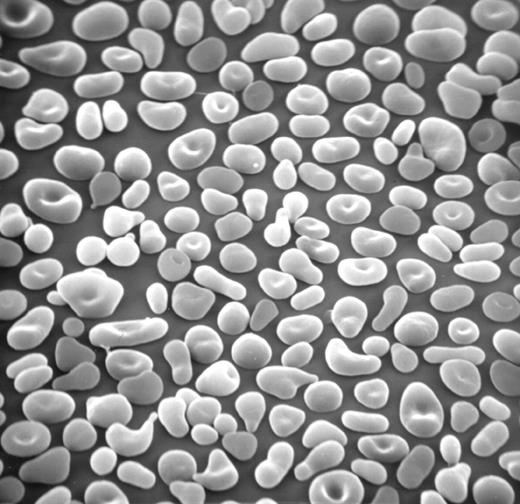Comment on Costa et al, page 4367
Molecular genetics has resolved many of history's venerable enigmas: it has identified the bones of the murdered Romanovs, laid bare the diseases of the ancient Egyptians, and now, in this issue of Blood, revealed the origins of a condition that has baffled hematologists since its discovery 30 years ago.
In 1975, Zarkowsky et al1 published their observations on 3 siblings afflicted by a severe hemolytic anemia with a red cell morphology that did not conform to those of either hereditary spherocytosis (HS) or hereditary elliptocytosis (HE). HS and HE, both first recognized in the late 19th century,2 are the most common red cell membrane disorders, with a frequency of 1 in 2000 to 5000, depending on the population. The clinical expression of both is highly variable, ranging from very mild to severe transfusion-dependent anemia.2 Molecular origins of both types of disorders have been deciphered in the last 2 decades. Mutations in red cell membrane proteins, ankyrin, band 3, protein 4.2, and β-spectrin account for more than 90% of HS,2 while mutations in α-spectrin account for a majority of cases of HE; the remaining cases of HE arise from mutations in β-spectrin or protein 4.1R.2,3
The blood of the 3 patients described by Zarkowsky et al contained red cells with blunted or triangular projections, as well as microspherocytes. Because of the resemblance of the observed red cell morphology to that seen in thermal injury and the finding that the patients' red cells fragmented at 45°C rather than 49°C like normal red cells, Zarkowsky et al designated the new disorder hereditary pyropoikilocytosis (HPP). The molecular basis for the red cell abnormalities in this family remained frustratingly undefined. This deficiency in our knowledge has now been remedied, for in this issue of Blood, Costa and colleagues reveal the solution of the mystery: they have shown convincingly that the original HPP kindred displays compound heterozygosity for an allele encoding a common structural variant of α-spectrin (L207P) identified in HE and an α-spectrin allele associated with a splice site mutation resulting in decreased production of normal α-spectrin. The combined effect of these mutations results in the assembly of weakly interacting spectrin dimers. The proportion of spectrin tetramers, which make up the membrane skeletal network of normal red cells, is accordingly decreased, as also therefore is the membrane's mechanical stability. Fragmentation of the cells and the characteristic shape abnormalities ensue.
What are the implications of the reported findings? A major implication is that HPP is not a distinct red cell entity, as was first suggested in 1975, but is a subset of HE in which the ability of spectrin to assemble into tetramers is heavily compromised. This conclusion is reinforced by the identification of other families with HPP, associated with homozygosity or compound heterozygosity for structural defects of α-spectrin, resulting in decreased membrane assembly of functional tetramers. The unresolved question is how defective spectrin tetramer formation leads to decreased heat resistance of the membrane. This is a puzzle that awaits further investigation. Patience, allegedly, is the greatest of all virtues, and so perhaps we should be prepared to wait another 30 years for an answer. ▪
Scanning electron micrograph documenting morphology of red cells in the kindred from the original HPP family. Marked red cell shape abnormalities include cells with blunted or triangular projections, as well as microspherocytes.
Scanning electron micrograph documenting morphology of red cells in the kindred from the original HPP family. Marked red cell shape abnormalities include cells with blunted or triangular projections, as well as microspherocytes.


This feature is available to Subscribers Only
Sign In or Create an Account Close Modal